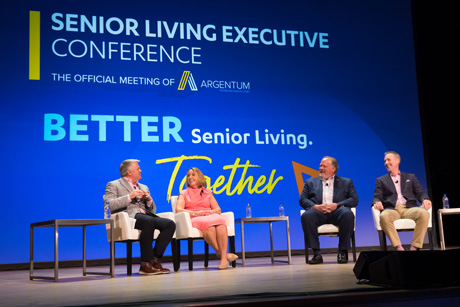MINNEAPOLIS — The worker shortage situation in seniors housing has improved marginally in recent months, but remains a “crisis,” said Tana Gall, president of Seattle-based Merrill Gardens, an owner-operator with a portfolio of 72 communities across 20 states. The veteran executive urged the industry to leave no stone unturned in its quest to find new employees, but discouraged the practice of operators poaching employees from competitors.
“What’s interesting to me, and a bit of a silver lining, is that during the pandemic I don’t think we felt that [workforce housing crisis] as much,” said Gall. “I didn’t see a lot of turnover as much as I would have expected. That just speaks to the level of the people who work with us — the people with heart who didn’t leave us high and dry during that time.
“But man, I’m feeling it now. I would say that in the last six months to a year, we’ve seen the Great Resignation. We’ve seen people just flat out burning out from what we do. I’m getting a little worried about that, but I remain incredibly optimistic [about the long-term outlook for the industry],” concluded Gall.
Rather than continue to woo employees away from their competitors, companies need to come together in a collegial fashion to find new workers to fill the void, Gall emphasized.
“There’s just not enough people. During the pandemic, we got a lot of great dining people. It seemed that it was the only time in my career that we had no openings in dining because restaurants were closed. And what great exposure it was for those folks to see what we do in such an amazing industry.”
Gall’s comments came during a panel session — titled “Insights from the C-Suite: People, Trust, Choice” — on the second day of Argentum’s 2022 Senior Living Executive Conference. Approximately 2,000 industry leaders have descended on the Minneapolis Convention Center for the conference, which May 16 to May 18 and features an Expo Hall. HMP Global produced the conference.
Joel Nelson, the newly named chairman of the Argentum Board and president and CEO of Des Moines, Iowa-based Life Care Services, moderated the panel. Along with Nelson and Gall, fellow panelists included Joe Eby, president of Bickford Senior Living based in Olathe, Kansas, and Chris Hyatt, president of New Perspective Senior Living headquartered in Minnetonka, Minnesota.
The turnover is placing a great burden on Bickford Senior Living as a whole, but particularly on caregivers and executive directors, according to Eby. Management has come to the realization that it needs to be flexible in its approach to caregivers, who prior to the pandemic routinely worked eight-hour, 10-hour or 12-hour shifts — basically whatever the executive director decided was best for the facility.
But that scheduling model doesn’t work any longer, said Eby. “We’re having to get creative with split shifts.” The complexity of devising split schedules puts a lot of pressure on executive directors. “Trying to find technology that supports that is a big burden for us right now to figure out.”
Hyatt concurred with the sentiments and experiences shared by Gall and Eby and pointed out that 89 percent of the industry’s workforce is female, according to data gleaned from Argentum and some of its partners. “What happened during the pandemic? A lot of children didn’t go to school,” said Hyatt. Consequently, many moms elected to stay home with their kids or were forced to care for aging parents unable to move into a senior living community due to pandemic-related timing issues.
The Wall Street Journal reported in October 2021 that nearly 4.3 million workers had dropped out of the workforce more than a year and a half into the pandemic. Of that 4.3 million, about 100,000 worked in the healthcare industry. Early retirement accounted for about half of 4.3 million workers that opted out, according to Hyatt.
“So, we’re all trying to figure out how we backfill the vacuum here as well as all the other [issues] that local operators are experiencing, which are fatigue, burnout and trying to just get people to boomerang back,” Hyatt explained.
“We’re not out of the woods yet. What I like about this panel is that no one is up here saying that they found the silver bullet. They haven’t. But we have started making some strides in the right direction,” added Hyatt, who described the changes in the macroeconomy over the past two years as “seismic shifts.”
Legislative update
Day two of the conference also featured a public policy presentation from Argentum’s public affairs staff, led by Senior Vice President Maggie Elehwany. The presentation focused on the efforts in Washington, D.C., to press Congress and the current administration on the need for immediate COVID-19 financial relief for senior living communities.
Operators are still recovering from the drop in occupancies and the simultaneous increase in expenses resulting from the pandemic, which negatively impacted their net operating income.
The public affairs team also pointed out that efforts are in full motion on getting legislative and administrative action on workforce programming for assisted living and memory care communities.
Keynote address
Innovation and marketing expert Rohit Bhargava ushered in the morning with his keynote address titled “How to Lead the Future with Non-Obvious Thinking.” Bhargava shared five usable habits to integrate into daily life to be more creative and see the world differently. He also discussed how fundamental forces of disruption are shifting consumer behavior and beliefs across industries, and what this means for the seniors housing sector.
Outside of his speaking and consulting, Bhargava is also an adjunct professor of marketing and storytelling at Georgetown University and writes a monthly column for GQ magazine in Brazil. His insights have also been featured on NPR, Fast Company, CNN and the Harvard Business Review.
— Matt Valley

